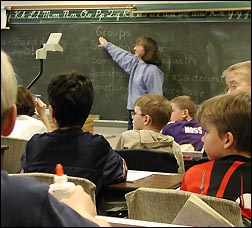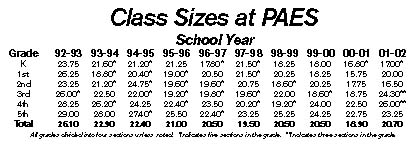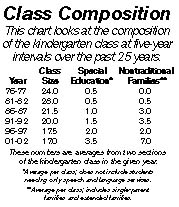School faces dilemma on class sizes
 It's the answer to a seemingly impossible riddle. What helped cause School District #741 present financial predicament? And at the same time what will help solve it?
It's the answer to a seemingly impossible riddle. What helped cause School District #741 present financial predicament? And at the same time what will help solve it?Answer: class sizes.
On one hand, because smaller class sizes offer better interaction between students and teachers and provide for more one-on-one attention, educators credit them with creating a better learning environment.
On the other hand, fewer students in the classroom means less revenue for the school, as the district's basic income comes from the state in the form of per pupil payments.
The Paynesville School District has done a better job than state averages in keeping class sizes small, according to data from the Department of Children, Families, and Learning. In each of the past seven school years, Paynesville has had lower student to teacher ratios and lower student to staff ratios than state averages.
Having smaller class sizes is a better way to educate students, according to superintendent Howard Caldwell. "No question," he said. "That's kind of a no-brainer, in my opinion. Anytime you can get a lower ratio of adults to students it's obvious that it's going to be a better learning environment."
One of Todd Burlingame's first memories of PAES when he came to interview for the principal job was the low class sizes. "I was impressed," he recalled, looking at the relatively short list of names outside the classrooms as he toured the school. "What I heard when I first came here was the board had made an effort to keep class sizes down. They did a good job."
"Back then, we could afford to do it," he added. "But we might not be able to do that now."
Pending cuts
The pending cuts that the school district will make to the 2002-03 budget will include cuts in staff that will increase class sizes next year, Caldwell warned the board in January. While the general fund pays for staff, supplies, utilities, maintenance, busing, and every other expense that doesn't have a designated fund, the majority of the general fund is salaries, which leaves few alternatives but "people cuts," said Caldwell.
(The list of potential cuts was released to the public on Tuesday night, after the Press's deadline. To see the list of potential cuts before the next issue of the Press, go online at www.paynesvillearea.com.)
 Keeping lower class sizes was one of the expenditures that led to the decline of the school district's general fund balance from a peak balance of $1,663,000 at the end of the 1996-97 school year to $57,000 at the end of the 2000-01 school year, said Caldwell. While the fund balance disappeared due to four consecutive years of deficit spending, Caldwell felt the money was spent on educating kids. "I think it all went for good things," he said. "It didn't go for frivolous things."
Keeping lower class sizes was one of the expenditures that led to the decline of the school district's general fund balance from a peak balance of $1,663,000 at the end of the 1996-97 school year to $57,000 at the end of the 2000-01 school year, said Caldwell. While the fund balance disappeared due to four consecutive years of deficit spending, Caldwell felt the money was spent on educating kids. "I think it all went for good things," he said. "It didn't go for frivolous things."
The impact that lower class sizes has on district finances is illustrated by the fact that the two years when the school district operated on the largest deficit (1997-98 and 2000-01) were the years when it had the lowest average class sizes at Paynesville Area Elementary School (PAES).
But while having lower class sizes benefitted students, balancing the budget and rebuilding the general fund will require enlarging class sizes, and running the school more efficiently economically.
Cuts already in place
The process of enlarging classes actually started this year. The district's budget for 2001-02 was cut by more than $500,000, and part of that resulted in larger classes.
In the elementary school, which will be the focus in this story, both the third and fourth grades were reduced from four sections (requiring four teachers) to three. The second grade was also reduced to three sections in the budget cuts, but federal dollars for an extra teacher enabled the district to hire another teacher and add a fourth section to the second grade.
As a result of the reduction to three sections, third grade classes this year average 24.3 students, up from 18.75 last year. Fourth grade classes now average 26.0 students, up from 22.5 last year.
"Instead of 18 talking, you've got 24 talking," said Marlys Sorenson, who has taught third graders at PAES for 30 years. She still says she is going to school, not going to work, but she has noticed that students these days no longer sit as quietly nor wait as patiently as they once did. "You wish you could be a Game Boy and entertain them all," she said.
During one of the first days of school, Sorenson was asked by a unimpressed student who was puzzled by the larger classes: "Why are there so many people in here?"
"They don't really have any space for themselves," said Sorenson looking at the desks in her classroom. "Look at those rows. You're practically touching someone else. That makes it so easy to talk. You just turn and someone else is there."
While the fourth grade has never benefitted from the lowest class sizes in the elementary school, an honor usually reserved for the lower grades, fourth grade teacher Connie Backes has noticed differences this year.
The first is the physical presence of more bodies, said Backes, who has taught at PAES since 1973. "When you get the kids in," she said as she surveyed her empty classroom after school last week, "we barely fit back to front."
And she has no complaints about her classroom, which used to be part of the woodshop before the new middle school was built in the early 1990s. It's a large room and the biggest classroom she's ever had.
But it still feels crowded now. "Most of them have their own space at home," she said of her students. "They're not used to being crowded." She says she hears more comments this year like "he's bumping me" and "I can't concentrate."
Her classroom also has the same number of computers, the same "near death" printer, but more kids needing to use them.
"There's just a difference in getting kids' attention and giving them one-on-one attention," she continued. "More kids want help than I can give."
"It takes longer to do a lesson because it takes longer to get all the kids on task," she added.
Greater needs
Reasons for keeping class sizes low are more abundant now than ever, according to district staff. "We've got more and more kids with needs," said Burlingame. "And more and more is put on the schools."
The elementary school not only is responsible for academic progress these days, he explained, but it must also mainstream special education students as much as possible, and teach drug education (D.A.R.E.) to fifth graders each year, with help from the Stearns County Sheriff's Department. "Our curriculum," he added, "Éhas accelerated, and we expect more at a younger age."
Sorenson and Backes agree that the curriculum these days is busier than ever. "We're always given something more to teach," Sorenson said. "We constantly have to throw more in."
"All the years I've done this it's gotten a little bit more difficult each year," said Backes, who has also taught kindergarten, first, and third grades at PAES. According to the new federal education law, in addition to grad standards and third and fifth grade testing mandated by the state, schools will have to test students in grades three through eight.
In addition to teaching more, education these days goes to all. Gone are the days when special education students are forgotten or institutionalized. Now they're in the regular classroom as much as possible.
"We're expecting all kids to do well and excel, even those who have trouble learning," said Backes.
"I think we're doing a better job now than ever before in e
ducating children," added Caldwell. The elementary school has more kids with unique needs, like kids from nontraditional homes and transitory students (who move from school to school). Every student in a typical kindergarten class 25 years ago lived at home with two parents. This year, over 40 percent of the students live either with a single parent or extended family.
 In his 22 years as a school social worker, Dave Mutschelknaus has seen an increase in troubled families and divorce. "When you have more troubled families, you have more troubled kids. Troubled kids take more time, from teachers, support staff, and administration," he said.
In his 22 years as a school social worker, Dave Mutschelknaus has seen an increase in troubled families and divorce. "When you have more troubled families, you have more troubled kids. Troubled kids take more time, from teachers, support staff, and administration," he said.
"The research is pretty clear," he said. "There's no unaffected kids from divorce."
Mutschelknaus, who actually works for the education district, says his job is to create the best emotional environment for kids during the school day to maximize their potential for learning. He thinks at-risk students will be hurt twice if class sizes are increased and support services are cut as well.
In 25 years as a kindergarten teacher, Colleen Pelton has noticed a trend of having more kids with needs beyond academics. For more and more kids with emotional and social needs, the first step is to get them comfortable with the school routine before teaching the ABCs can even begin.
Having consistency is one reason the kindergarten teachers support having children come to school everyday, Pelton added. Changing kindergarten to all-day, every-other day was proposed as a cut last year but was saved.
One positive Pelton sees these days is having more dads involved with elementary-aged children.
The majority of parents still do wonderful jobs with their kids, said Burlingame. So wonderful, in fact, that he sometimes wants to send his kids home with other parents, he jokes. But, the needs of kids on the other end of the spectrum are growing. "They're more and more kids where we're doing extra things for them to be successful," said Burlingame, "because we want all our kids to be successful."
Another thing elementary, especially kindergarten, teachers are noticing, according to Burlingame, is a bigger disparity in the academic abilities of their class members. Even with class sizes low like they have been "you don't get to all the kids you should," he said. "You need more one-on-one attention."
"We've been fortunate that our board provided (low class sizes) as long as we could," said Backes. "When we had money available, they placed children first."
Contact the author at paypress@lkdllink.net • Return to News Menu
Home | Marketplace | Community